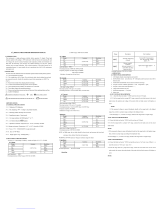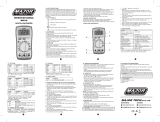
DVM860BL - 1 - VELLEMAN
DVM860BL – DIGITAL MULTIMETER
1. Introduction
At the end of its life cycle, dispose of this product in accordance with local and national disposal
regulations. Read the manual thoroughly before bringing this device into service
Thank you for buying the DVM860BL! Use this device to measure and test: AC & DC voltage & current (also with
optional clamp AC97), resistance, temperature, batteries, diodes, continuity and transistors.
2. Safety
The DVM860BL is developed in accordance with IEC1010-1 concerning safety requirements for electrical measuring
instruments with an overvoltage category (CAT III) 600V and pollution 2. Respect these safety prescriptions:
• Protect yourself against electroshocks.
• Do not use this device for any other application than those described in this manual.
• Make sure the device was not damaged in transit.
• Make sure the insulation of the test leads is not damaged and/or the wire itself is not exposed.
• Full compliance with safety standards can only be guaranteed if the device is used with the supplied test leads. If
necessary, they should be replaced with identical leads or leads with identical electric ratings. All test leads should
be in good working order.
• Select the right input jack, function and range before use.
• Never exceed the specified limit values for the various measurement ranges.
• Do not touch unused terminals when the meter is connected to a circuit.
• Place the range selector in the highest position if the value to be measured is unknown beforehand.
• Do not measure voltages > 600V above earth ground.
• Exercise extreme caution when working with voltages in excess of 60Vdc or 30Vrms AC. Keep your fingers behind
the probe barriers while using the device.
• Do not connect the leads to a voltage source while the function switch is in one of the following modes: current,
resistance, temperature, battery, diode, transistor or continuity.
• Disconnect all test leads from the circuit to be tested prior to selecting a different function or range.
• Do not use the meter in dusty environments or in the presence of flammable gases and steam.
• Have the device checked by a qualified technician in case of malfunction.
• Never use the meter if the back panel is not in place and firmly fixed.
• Do not use or store the device in areas exposed to direct sunlight, high temperatures or high humidity.
3. Device Description
a. Front Panel
1. LCD display : allows readout of the measured values
2. ON/OFF button : used to activate / deactivate the device
3. RANGE button : used to select auto or manual range
4. FUNC. button : select AC or DC measurement, select °C or °F
5. Selector : used to select the desired function and range
6. 10A jack : input terminal for max. 10A current
7. INPUT jack : input terminal (exception: 10A)
8. COM jack
9. Backlight button ( ) : to illuminates the LCD for a few seconds
10. DATA HOLD button : Displayed data are held
11. MAX HOLD button : Max. measured value is held













